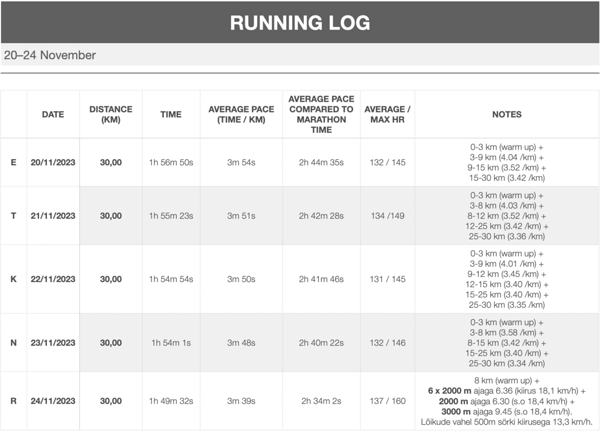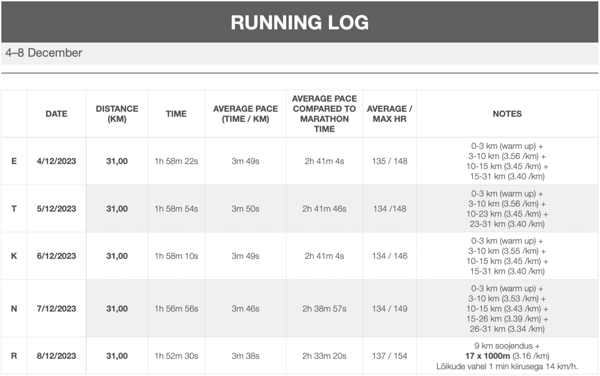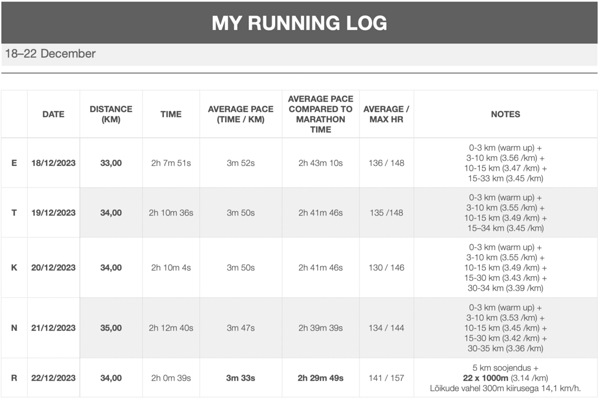On Christmas Eve, I successfully completed a seven-week long training cycle. Considering the prevalence of viruses lately, one of the major achievements can be seen as staying healthy. This is despite my dear spouse being sick for several weeks, and our son Rasmus catching the bug multiple times. On a couple of evenings after intense workouts, I had to wear a mask at home as a precaution to avoid falling ill because the virus concentration in the air was clearly not in my favor :).

Photo: Stefan Meier
During these seven weeks, I cycled 39 times, had 24 swimming sessions, completed 23 strength training sessions (mostly bodyweight exercises, averaging 17 minutes each session), and went running 47 times. The cycling workouts followed a 2+1 structure (I use the Wahoo SYSTEM training platform). Long and speed-endurance running sessions were scheduled for weeks 3, 5, and 7. Since the impact from running is most challenging for the muscles and considering it’s the final and most demanding discipline in ultratriathlon, running has become the best way for me to train my mind. I have pushed the limits of my endurance quite far and set demanding time goals for myself for the next year. So, I have to go a long way in training to achieve progress and strengthen my mental capacity.
In endurance sports, our ability to give our best effort largely depends on how hard we perceive that effort to be. When we are mentally tired, we perceive the effort as much harder. In the context of sports, it means that as fatigue accumulates, we must expend more mental effort to resist the “temptation” to slow down or even stop. To push our limits, we need to train our brains to cope better with fatigue. Triathlon is a good example – the further you go, the more fatigue you have to face and overcome. In an ultra triathlon, essentially all effort must be done from a fatigued state, and success favors those who can demonstrate greater resistance to the negative effects of mental and physical fatigue.
Therefore, this aspect plays a significant role in my training, manifesting in weeks-long cycles with increasing loads and challenging consecutive and bact-to-back training days. For example, in this particular training cycle, it manifested in three five-day running challenges.
In week 3, this meant 30 km run on five consecutive days. The challenge was not so much the length of the runs (I have gone much farther in previous training sessions and challenges) but rather the combination of running distances and speeds.

In the 5th week, I completed 5 x 31 km runs. Compared to the previous week, I slightly extended the distance while simultaneously increasing the speed. It’s also important to note that this week was preceded by a hard cycling workout, adding significant fatigue to the legs.

In the final, 7th week, I ran 5 x 33-35 km. This time, I extended the distance by an average of three km, and for interval training, I increased the number of segments. Additionally, I scheduled several challenging cycling workouts for the 7th week because the body had previously shown an incredibly fast recovery rate, allowing for some extra intensity. For example, before the Tuesday long run, I had an FTP development workout on the bike in the morning (i.e., 5 x 7 minutes at a power output of 314-327 watts). However, if you compare Tuesday’s run with Monday’s, the numbers do not show that I made a strong effort 4.5 hours before the run on Tuesday morning. In reality, the legs were quite fatigued after the bike ride, but recovery is simply incredibly fast. Interestingly, running itself has become one of the fastest ways to recover – starting the run, there was considerable fatigue in the legs, but with each kilometer, the feeling improved, and lightness returned to the legs quickly.

Monitoring body signals and self-feeling are central in my training – this way, I best sense the delicate boundary, crossing which could result in a serious setback. Last week’s speeds, heart rates, feeling of well-being during training and comparison with previous years’ training cycles confirm that there has been significant progress. This, in turn, gives me confidence that the training principles followed this year have proven themselves. The work continues into the new year, and hopefully, the current running form will yield good results in an early spring marathon.